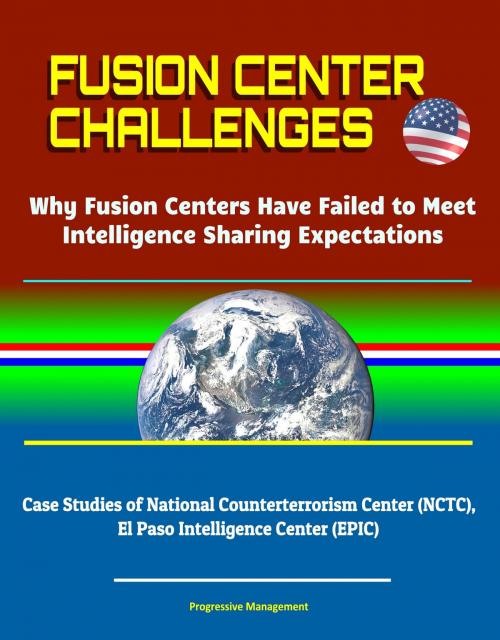Fusion Center Challenges: Why Fusion Centers Have Failed to Meet Intelligence Sharing Expectations - Case Studies of National Counterterrorism Center (NCTC), El Paso Intelligence Center (EPIC)
Nonfiction, Social & Cultural Studies, Political Science, Politics, Law Enforcement| Author: | Progressive Management | ISBN: | 9780463644898 |
| Publisher: | Progressive Management | Publication: | June 10, 2018 |
| Imprint: | Smashwords Edition | Language: | English |
| Author: | Progressive Management |
| ISBN: | 9780463644898 |
| Publisher: | Progressive Management |
| Publication: | June 10, 2018 |
| Imprint: | Smashwords Edition |
| Language: | English |
This excellent 2018 report has been professionally converted for accurate flowing-text e-book format reproduction.
This study intends to uncover why critics have cited fusion centers at the national, regional, and state levels of the Intelligence Community (IC) for the inability to share intelligence. The research method examines three case studies: the National Counterterrorism Center (NCTC), the El Paso Intelligence Center (EPIC), and state and local fusion centers now combined into a National Network. All three case studies reveal how fusion centers at these various levels of the IC have been inhibited from sharing information because of three primary challenges: (1) the absence of a standardized model, (2) an insufficient concentration on counterterrorism (CT) as a mission, and (3) underdeveloped or missing external agency partnerships, although each challenge often affects each particular case study in different ways. For NCTC, external partnerships exhibit the most prevalent challenge at the national level; for EPIC, the diffusion of its mission creates the most difficult obstacle for it to overcome; and for the National Network, standardization precludes state and local fusion centers from sharing information while barring them from a more refined mission-set and better, more reciprocal partnerships.
I. INTRODUCTION * A. THE PRIMARY PROBLEM WITH FUSION CENTERS * B. WHY FUSION CENTERS EXIST * C. WHY FUSION CENTERS FAIL TO SHARE INFORMATION * 1. Critiques of Fusion Centers * 2. The Absence of a Standardized Model * 3. The Counter-Terrorism Mission * 4. Underdeveloped or Missing External Agency Partnerships * 5. Conclusions * D. WHAT THE ANALYSIS REVEALS * E. RESEARCH DESIGN AND CASE STUDIES * F. THESIS OVERVIEW AND CHAPTER OUTLINE * II. THE NATIONAL COUNTERTERRORISM CENTER * A. INTRODUCTION * B. BACKGROUND * 1. Executive Order 13354 * 2. The Intelligence Reform and Terrorism Prevention Act * 3. The Mission of NCTC * 4. The Functions of NCTC * 5. The Structure of NCTC * C. REVIEWS, CRITICISM, AND SUPPORT FOR THE NCTC * D. THE LACK OF A STANDARDIZED MODEL * E. COUNTERTERRORISM AS A MISSION * F. UNDERDEVELOPED OR MISSING EXTERNAL AGENCY PARTNERSHIPS * 1. NCTC's Partnership Problem * 2. NCTC Partnership Achievements and Solutions * G. SUMMARY * III. THE EL PASO INTELLIGENCE CENTER * A. INTRODUCTION * B. THE BACKGROUND OF EPIC * C. REVIEWS, CRITICISM, AND SUPPORT FOR EPIC * D. THE ABSENCE OF A STANDARDIZED MODEL * E. COUNTERTERRORISM AS A MISSION * F. UNDERDEVELOPED OR MISSING EXTERNAL AGENCY PARTNERSHIPS * G. SUMMARY * IV. STATE AND LOCAL FUSION CENTERS * A. INTRODUCTION * 1. Differences in Opinion between State and Federal Leaders. * B. THE BACKGROUND OF FUSION CENTERS * 1. The Founding History * 2. The Information Sharing Environment (ISE) * 3. Priorities and Functions of State and Local Fusion Centers * C. REVIEWS, CRITICISM, AND SUPPORT FOR FUSION CENTERS * D. THE ABSENCE OF A STANDARDIZED MODEL * 1. The Lack of Standardization as a Benefit * E. COUNTERTERRORISM AS A MISSION * 1. An Expanded Mission * 2. The Relationship between Crime and Terror * 3. The Way Ahead * F. UNDERDEVELOPED OR MISSING EXTERNAL AGENCY PARTNERSHIPS * 1. The Way Ahead * G. SUMMARY * V. CONCLUSION * A. NCTC * 1. The Lack of a Standardized Model * 2. Counterterrorism as a Mission * 3. Underdeveloped or Missing External Agency Partnerships * B. EPIC * 1. The Lack of a Standardized Model * 2. Counterterrorism as a Mission * . Underdeveloped or Missing External Agency Partnerships * C. STATE AND LOCAL FUSION CENTERS * 1. The Lack of a Standardized Model * 2. Counterterrorism as a Mission * 3. Underdeveloped or Missing External Agency Partnerships. * D. RECOMMENDATIONS * E. FINAL THOUGHTS * 1. The Largest Hurdle
This excellent 2018 report has been professionally converted for accurate flowing-text e-book format reproduction.
This study intends to uncover why critics have cited fusion centers at the national, regional, and state levels of the Intelligence Community (IC) for the inability to share intelligence. The research method examines three case studies: the National Counterterrorism Center (NCTC), the El Paso Intelligence Center (EPIC), and state and local fusion centers now combined into a National Network. All three case studies reveal how fusion centers at these various levels of the IC have been inhibited from sharing information because of three primary challenges: (1) the absence of a standardized model, (2) an insufficient concentration on counterterrorism (CT) as a mission, and (3) underdeveloped or missing external agency partnerships, although each challenge often affects each particular case study in different ways. For NCTC, external partnerships exhibit the most prevalent challenge at the national level; for EPIC, the diffusion of its mission creates the most difficult obstacle for it to overcome; and for the National Network, standardization precludes state and local fusion centers from sharing information while barring them from a more refined mission-set and better, more reciprocal partnerships.
I. INTRODUCTION * A. THE PRIMARY PROBLEM WITH FUSION CENTERS * B. WHY FUSION CENTERS EXIST * C. WHY FUSION CENTERS FAIL TO SHARE INFORMATION * 1. Critiques of Fusion Centers * 2. The Absence of a Standardized Model * 3. The Counter-Terrorism Mission * 4. Underdeveloped or Missing External Agency Partnerships * 5. Conclusions * D. WHAT THE ANALYSIS REVEALS * E. RESEARCH DESIGN AND CASE STUDIES * F. THESIS OVERVIEW AND CHAPTER OUTLINE * II. THE NATIONAL COUNTERTERRORISM CENTER * A. INTRODUCTION * B. BACKGROUND * 1. Executive Order 13354 * 2. The Intelligence Reform and Terrorism Prevention Act * 3. The Mission of NCTC * 4. The Functions of NCTC * 5. The Structure of NCTC * C. REVIEWS, CRITICISM, AND SUPPORT FOR THE NCTC * D. THE LACK OF A STANDARDIZED MODEL * E. COUNTERTERRORISM AS A MISSION * F. UNDERDEVELOPED OR MISSING EXTERNAL AGENCY PARTNERSHIPS * 1. NCTC's Partnership Problem * 2. NCTC Partnership Achievements and Solutions * G. SUMMARY * III. THE EL PASO INTELLIGENCE CENTER * A. INTRODUCTION * B. THE BACKGROUND OF EPIC * C. REVIEWS, CRITICISM, AND SUPPORT FOR EPIC * D. THE ABSENCE OF A STANDARDIZED MODEL * E. COUNTERTERRORISM AS A MISSION * F. UNDERDEVELOPED OR MISSING EXTERNAL AGENCY PARTNERSHIPS * G. SUMMARY * IV. STATE AND LOCAL FUSION CENTERS * A. INTRODUCTION * 1. Differences in Opinion between State and Federal Leaders. * B. THE BACKGROUND OF FUSION CENTERS * 1. The Founding History * 2. The Information Sharing Environment (ISE) * 3. Priorities and Functions of State and Local Fusion Centers * C. REVIEWS, CRITICISM, AND SUPPORT FOR FUSION CENTERS * D. THE ABSENCE OF A STANDARDIZED MODEL * 1. The Lack of Standardization as a Benefit * E. COUNTERTERRORISM AS A MISSION * 1. An Expanded Mission * 2. The Relationship between Crime and Terror * 3. The Way Ahead * F. UNDERDEVELOPED OR MISSING EXTERNAL AGENCY PARTNERSHIPS * 1. The Way Ahead * G. SUMMARY * V. CONCLUSION * A. NCTC * 1. The Lack of a Standardized Model * 2. Counterterrorism as a Mission * 3. Underdeveloped or Missing External Agency Partnerships * B. EPIC * 1. The Lack of a Standardized Model * 2. Counterterrorism as a Mission * . Underdeveloped or Missing External Agency Partnerships * C. STATE AND LOCAL FUSION CENTERS * 1. The Lack of a Standardized Model * 2. Counterterrorism as a Mission * 3. Underdeveloped or Missing External Agency Partnerships. * D. RECOMMENDATIONS * E. FINAL THOUGHTS * 1. The Largest Hurdle















